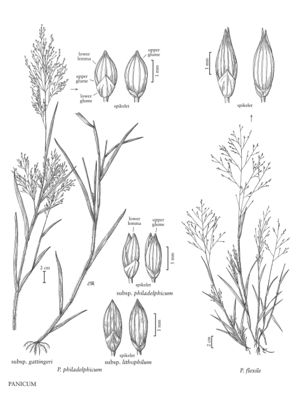Difference between revisions of "Panicum flexile"
FNA>Volume Importer |
imported>Volume Importer |
||
| (7 intermediate revisions by 2 users not shown) | |||
| Line 4: | Line 4: | ||
|publications= | |publications= | ||
|common_names=Wiry witchgrass;Panic flexible | |common_names=Wiry witchgrass;Panic flexible | ||
| + | |special_status={{Treatment/ID/Special_status | ||
| + | |code=E | ||
| + | |label=Endemic | ||
| + | }} | ||
|basionyms= | |basionyms= | ||
|synonyms= | |synonyms= | ||
| Line 16: | Line 20: | ||
-->{{Treatment/Body | -->{{Treatment/Body | ||
| − | |distribution=Ala.;Ill.;Ind.;Ky.;Pa.;W.Va.;D.C;Wis.;Ont.;Que.;Fla.;N.J.;Iowa;N.Dak.;S.Dak.;Tex.;La.;N.C.;Tenn.;N.Y.;Va.;Ark.;Vt.;Ga.;Mass.;Conn.;Md.;Kans.;Okla.;Ohio;Utah;Mo.;Minn.;Mich.;Miss.;S.C. | + | |distribution=Ala.;Ill.;Ind.;Ky.;Pa.;W.Va.;D.C.;Wis.;Ont.;Que.;Fla.;N.J.;Iowa;N.Dak.;S.Dak.;Tex.;La.;N.C.;Tenn.;N.Y.;Va.;Ark.;Vt.;Ga.;Mass.;Conn.;Md.;Kans.;Okla.;Ohio;Utah;Mo.;Minn.;Mich.;Miss.;S.C. |
|discussion=<p><i>Panicum flexile</i> grows in fens and other calcareous wetlands, in dry, calcareous or mafic rock barrens, and in open woodlands, especially on limestone derived soils. It is restricted to the Flora region.</p> | |discussion=<p><i>Panicum flexile</i> grows in fens and other calcareous wetlands, in dry, calcareous or mafic rock barrens, and in open woodlands, especially on limestone derived soils. It is restricted to the Flora region.</p> | ||
|tables= | |tables= | ||
| Line 26: | Line 30: | ||
-->{{#Taxon: | -->{{#Taxon: | ||
name=Panicum flexile | name=Panicum flexile | ||
| − | |||
|authority=(Gatt.) Scribn. | |authority=(Gatt.) Scribn. | ||
|rank=species | |rank=species | ||
| Line 33: | Line 36: | ||
|basionyms= | |basionyms= | ||
|family=Poaceae | |family=Poaceae | ||
| − | |distribution=Ala.;Ill.;Ind.;Ky.;Pa.;W.Va.;D.C;Wis.;Ont.;Que.;Fla.;N.J.;Iowa;N.Dak.;S.Dak.;Tex.;La.;N.C.;Tenn.;N.Y.;Va.;Ark.;Vt.;Ga.;Mass.;Conn.;Md.;Kans.;Okla.;Ohio;Utah;Mo.;Minn.;Mich.;Miss.;S.C. | + | |illustrator=Linda A. Vorobik;Cindy Roché |
| + | |illustration copyright=Utah State University | ||
| + | |distribution=Ala.;Ill.;Ind.;Ky.;Pa.;W.Va.;D.C.;Wis.;Ont.;Que.;Fla.;N.J.;Iowa;N.Dak.;S.Dak.;Tex.;La.;N.C.;Tenn.;N.Y.;Va.;Ark.;Vt.;Ga.;Mass.;Conn.;Md.;Kans.;Okla.;Ohio;Utah;Mo.;Minn.;Mich.;Miss.;S.C. | ||
|reference=None | |reference=None | ||
|publication title= | |publication title= | ||
|publication year= | |publication year= | ||
| − | |special status= | + | |special status=Endemic |
| − | |source xml=https:// | + | |source xml=https://bitbucket.org/aafc-mbb/fna-data-curation/src/200273ad09963decb8fc72550212de541d86569d/coarse_grained_fna_xml/V25/V25_1238.xml |
|subfamily=Poaceae subfam. Panicoideae | |subfamily=Poaceae subfam. Panicoideae | ||
|tribe=Poaceae tribe Paniceae | |tribe=Poaceae tribe Paniceae | ||
Latest revision as of 17:56, 11 May 2021
Plants annual; delicate, green or yellow-green. Culms 10-75 cm, about 1 mm thick, simple or with erect basal branches; nodes densely pilose, hairs ascending; internodes glabrous or shortly pubescent distally. Sheaths longer than the internodes, green to purplish, hispid, margins sparsely ciliate; ligules 0.5-1.5 mm; blades 3-32 cm long, 1-7 mm wide, ascending to erect, linear, narrowing basally, flat or the margins involute, surfaces sparsely hirsute or pilose (rarely glabrous), hairs near the base papillose-based, margins prominent, apices acute. Panicles 5-45 cm long, 1-6 cm wide, at least 1/2 as long as the plants and 3 times longer than wide, open; rachises glabrous; primary branches usually alternate or subopposite, ascending to slightly divergent, secondary branches and pedicels attached to the distal 2/3; secondary branches diverging; pedicels 0.5-17 mm, ascending to appressed. Spikelets 2.5 - 3.7 mm long, 0.6-1.1 mm wide, narrowly ovoid, glabrous, acute; lower glumes 0.8-1.3 mm, 1/3 – 1/2 as long as the spikelets, acuminate; upper glumes 2.3-3.3 mm, 7-9-veined, exceeding the upper florets by about 0.6 mm; lower florets sterile; lower lemmas 2.2-2.7 mm, exceeding the upper florets by about 0.6 mm, 7- or 9-veined, apices scabridulous, pointed; lower paleas absent; upper florets 1.6-1.7 mm long, about 0.6 mm wide, usually smooth, usually pale, sometimes becoming dark at maturity. 2n = 18.
Distribution
Ala., Ill., Ind., Ky., Pa., W.Va., D.C., Wis., Ont., Que., Fla., N.J., Iowa, N.Dak., S.Dak., Tex., La., N.C., Tenn., N.Y., Va., Ark., Vt., Ga., Mass., Conn., Md., Kans., Okla., Ohio, Utah, Mo., Minn., Mich., Miss., S.C.
Discussion
Panicum flexile grows in fens and other calcareous wetlands, in dry, calcareous or mafic rock barrens, and in open woodlands, especially on limestone derived soils. It is restricted to the Flora region.
Selected References
None.
